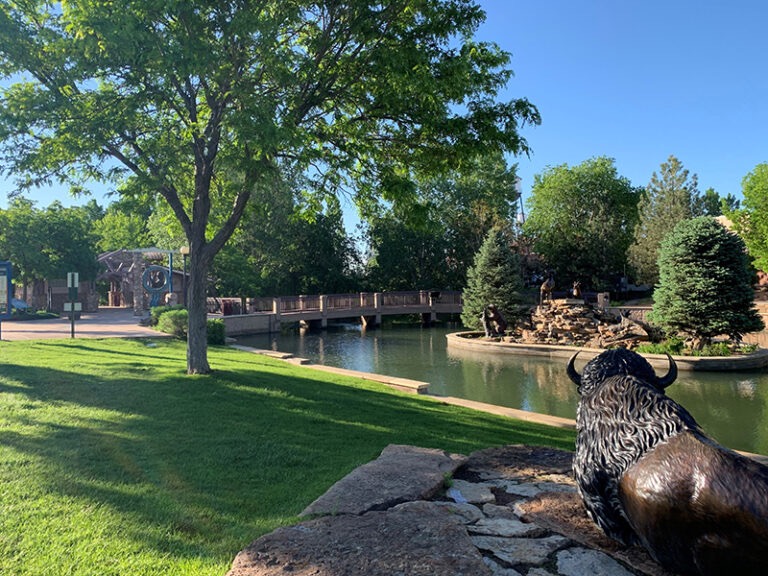When you think ‘riverwalk,’ you almost automatically, think San Antonio. The Texas city is home to the country’s most elaborate riverwalk. But if you aren’t in San Antonio or don’t feel like taking the drive or flight, ‘think Pueblo.’ Yeah! Think Pueblo! It not only has a riverwalk but plans just got green-lit to make it even better.
Pueblo’s Historic Arkansas Riverwalk Project, HARP, became a reality in October of 2000. The idea had been tossed around for years by city leaders thinking it might be a way of revitalizing the economy during some very down economic times. Today it has become one of Pueblo’s crown jewels attracting thousands of both locals and visitors each year. It’s now preparing for its fourth expansion.

The Riverwalk intersects the city’s historic Union Avenue, one of Pueblo’s main arteries and now, also, one of the city’s most upscale destinations. It’s a district featuring a balance of the old and the new, including restaurants, boutiques and antique shops.
The $16 million project will be paid for with city, county, state and federal government money. Besides paying to lengthen the waterway, the money will also cover the cost of a planned multi-purpose boathouse.
Pueblo Mayor Heather Graham has promoted it since her days on the Pueblo City Council and HARP board member. As Mayor she also endorsed using funds from the city’s half-cent sales tax to help supplement the expansion. “What better of a way to use the half cent sales tax dollars,” she told The Pueblo Chieftain, “than to try to generate more businesses maybe coming to town, or more volume coming into Pueblo’s jewel, the riverwalk.”
The waterway, said Steven Meier, Pueblo’s Director of Parks and Recreation, will be extended “east over to Santa Fe (Avenue) and give the channel another front door.” That portion of the project will be the most expensive component of the undertaking, costing $4 million dollars.
Of course, the project will entail a bit of inconvenience or “setbacks,” as Meier described it. “We’ll drain the channel,” he said, adding that sidewalks will also be removed, and other detours will also be necessary. But, he promises, that any impact to the community will be “minimized.” The drainage will also be short term.
While the Arkansas River today runs south of the city’s business district, it is not the natural path of the river. The Riverwalk actually recreates its original route.
For those unfamiliar with the Arkansas River, it has historically been the lifeblood of so many things in the region going back centuries when indigenous people, including Apache, Comanche, and Ute Indians, called it home.
Of course, today the river is the principal water source for the agricultural riches produced in the eponymously named Arkansas Valley. Farmers and ranchers, both in Pueblo County and eastward to the Kansas border, rely on its water for irrigating everything from alfalfa to watermelon. Of course, Pueblo’s legendary chili is also one of its beneficiaries.
It was the flood of 1921 that caused city planners and the Army Corps of Engineers to reroute the river. The flood, considered one of southern Colorado’s worst ever natural disasters, caught the city by surprise on June 3rd of that year.
A deluge causing the Arkansas and Fountain Rivers to overflow and overpower any restraints destroyed nearly all of the city’s business district and in the process killed as many as 200 people in the city and downstream, drowned many times that number in livestock and was estimated to have caused $25 million in destruction or $325 million in today’s dollars.
The Riverwalk today also provides recreation for paddle boarders, kayakers and peddle boats—oversized duck replicas—can also be rented. It is also landscaped as an oasis in the city with plenty of shade to shield the sun during Pueblo’s summer months. Boat season on the Riverwalk is from May through September.
While the Pueblo Riverwalk is not San Antonio, it nonetheless offers locals and visitors an aquatic getaway in the city. “Visitors can expect to see beautiful gardens… and horticulture,” said HARP Executive Director Lynn Clark.
“It’s a great place to get out and enjoy the beauty of the environment, including a little bit of wildlife that adds to the experience.”
Visitors to the Riverwalk also have a chance to spend time at Veterans’ Bridge. The bridge honors veterans, those who fought in wars or served in peacetime. The names of 7,148 veterans are displayed on the bridge along with the name of four of the city’s Medal of Honor recipients.
Now approaching its 25th year, the Riverwalk has hosted everything from graduations to reunions to weddings. The planned boathouse that will be part of the expansion, said Clark, will add a bit of cachet to the experience. It will house HARP offices and have a rooftop area for both public and private events. It will also provide a view of the city.
Construction will begin in May with an estimated completion in 18 months.





